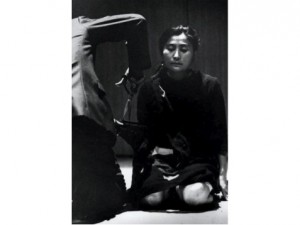Performance and Body Art in the 1970s:
From the end of the 1960s forward, an interest in “body” art emerged, in which both male and female artists turned to the “isolated physical self,” sacrificing themselves to risky and distressing actions as a means to shock their audiences and to challenge commodification of art by museums and galleries. During this period of political and social activism, Marina Abramović, along with Carolee Schneemann, Vito Acconci, Yoko Ono, and other artists, turned to the physical presence of the body in performance and body art as an attempt to jolt the viewer from their traditional role of passivity. Performance through the medium of the body became a place to acknowledge issues linked to women’s agency, as well as issues of race, sexuality, and otherness. This heightened interest in performance emerged along with the influence of Fluxus, started by George Maciunas in the 1960s, in which artists embraced chance and audience interaction as a means to “purge the world of dead art.”
Duration:
Durational works became increasingly popular in the 1970s for their rejection of traditional authorship or regularity, in direct opposition to the commodity culture related to the gallery or institution. These durational works were continuously in flux and therefore unpredictable and did not fit within a traditional gallery setting. Since the 1970s, Abramović has been a pioneer for the use of performance as a visual art form, using the body and duration as a means to test her mental and physical limits. In these durational works, such as her Rhythms series (1973-74) or Lips of Thomas (1975) (video available here), the long periods of time are used to push Abramović’s mental and physical limits, while also challenging the passivity of the viewer, who is made increasingly uncomfortable in watching the artist’s own suffering.
For more details, an informative, concise overview of performance in the 1960s and 1970s is available on the Walker Art Center’s website here.
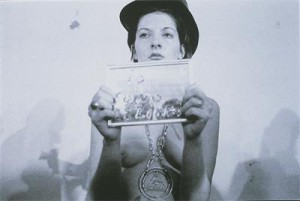
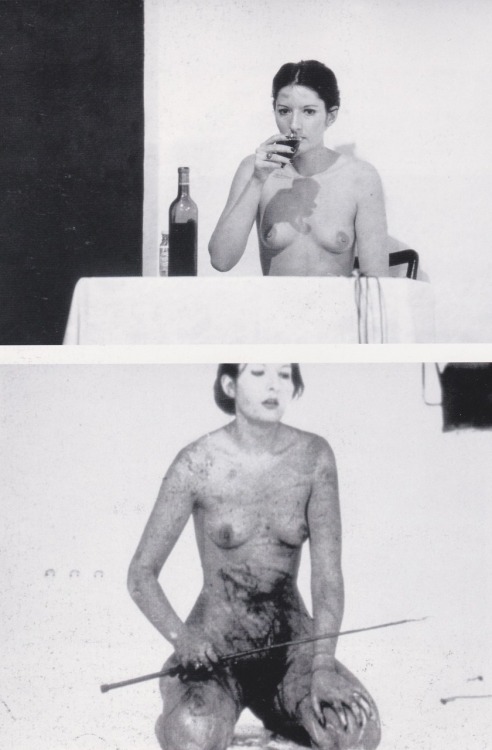
Follow the links below to learn about other major body art and performance artists of the 1960s and 1970s:
Carolee Schneemann:
In Schneemann’s 1975 Interior Scroll Schneemann, after applying paint to her face and body, and enacting a series of “life model action poses,” slowly drew a scroll of paper from her vagina and read aloud from it. By embracing core imagery through the presentation of her naked body, Schneemann rejected the phallus in favor of female sexual empowerment: “Using my body as an extension of my painting-constructions challenged and threatened the psychic territorial power lines by which women, in 1963, were admitted to the Art Stud Club, so long as they behaved enough like the men, and did work clearly in the traditions and pathways hacked out by men.”
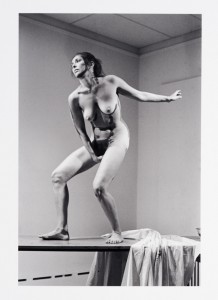
Vito Acconci:
In 1971 Vito Acconci lay hidden under a wooden ramp in New York’s Sonnabend Gallery, and intermittently masturbated, basing his sexual fantasies off of the sounds of the gallery visitors above him. Acconci expressed these fantasies aloud, where they were then projected through speakers into the gallery space. The piece emphasizes the vital role of the viewer, whose actions directly influence the development of the work. The visitors are taken out of a role of passivity and instead are unexpectedly objectified by Acconci’s actions below the ramp.
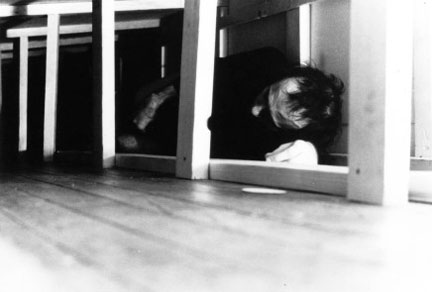
Another female artist who was incorporating the viewer as a vital component in performance art in the 1960s and 1970s is Yoko Ono. In 1964 Ono performed Cut Piece, in which Ono sat passively on a stage, fully clothed, and invited her audience members to mount the stage and cut off a piece of her clothing using the scissors she placed on the floor beside her. This performance reflects Ono’s participation in the Fluxus movement, through her emphasis on audience interaction. The performance is dependent on the actions and reactions of her viewers, and therefore is unpredictable and constantly in flux.
